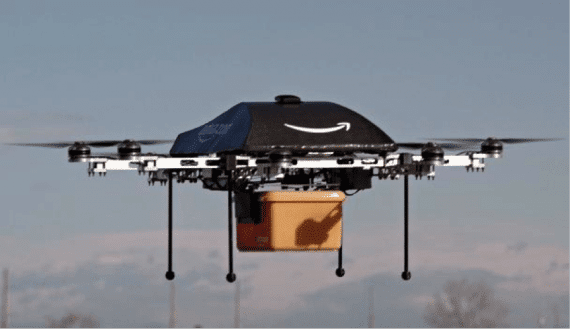8 Obstacles to Drone Delivery, for Ecommerce
The military has used drones for years, for a variety of missions. Now ecommerce retailers are evaluating their use.
Consumer research firm eDigitalResearch conducted a survey that found that 33 percent of online shoppers are open to using drones to speed up the delivery of their orders. Another study conducted by Walker Sands Communications reported that 66 percent of the surveyed American consumers think that online merchants will use drones for delivery within the next five years.
Consumers are apparently keen to utilize this technology, in other words. Amazon’s announcement in 2014 of a potential drone-based delivery service called Amazon Prime Air has led other retailers to consider drones.

Amazon Prime Air
While the U.S. Federal Aviation Administration is evaluating the use of drones and the regulations related to them, there are challenges retailers need to overcome before drone-based order delivery becomes a reality.
In this article, I’ll list eight of them.
8 Obstacles to Drone Delivery
1. Order staging. Before orders are shipped, they are typically assembled in a staging or docking area in a warehouse to be loaded into trucks. With drones, this docking process will need to be redesigned and may require changes to how products are picked for an order. This is not a small change, as existing processes will have to be redesigned for supporting drones and employees will need to be trained on these new processes to make drone delivery successful.
2. Weight limit. Since drones can presumably only support orders below a certain weight, the retailer may have to split the order into multiple shipments. This will increase the delivery costs and will need to be somehow offset or passed down to the consumer.
3. Drop ship vendors. Many retailers use drop ship vendors. These vendors will have to invest in drones to support faster delivery, to remain competitive, or retailers will have to look for other options.
4. Distance limit. Drones can travel only a certain distance. This may require retailers to load the drones, along with the ordered products, in delivery trucks and use drones for delivery only when they are within a defined radius for customer deliveries.
5. Requires investment. Introducing drones as part of the delivery process requires investment. But this investment will be a bigger strain on smaller retailers — or use third party services that utilize drones.
6. Shipping big-ticket items. Drones fly a few hundred feet from the ground and could become targets of thieves who want to steal merchandise. Retailers will have to consider this before using drones to ship big-ticket items. Retailer shrinkage could increase significantly after introducing drones.
7. Weather restrictions. A customer who signs up for faster delivery using drones will need his orders to be delivered regardless of the weather. Drones are not ideal for inclement weather, such as snow, hail, rain, and high winds, which could delay delivery to the customer.
8. Uninterrupted service. Drones are machinery that can fail. When that occurs, retailers will presumably have to send another drone to deliver an order. They will also have to determine how to collect the broken drone or write it off as loss.
In short, drone technology sounds exciting. But the reality of putting it into use is not straightforward. While the F.A.A. considers regulations on the use of drones, retailers can ponder and plan their strategy.
No comments:
Post a Comment